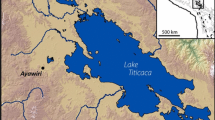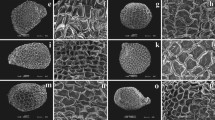Abstract
Cucurbita seeds are difficult to identify to species level using only their external morphology. In this contribution, we discuss anatomical features of fresh, dehydrated and experimentally carbonised specimens that are useful for the identification of archaeological Cucurbita seeds. Qualitative and quantitative differences in the seed coat micromorphology were found to be the most helpful diagnostic characteristics of South American Cucurbita species.








Similar content being viewed by others
References
Cutler H, Whitaker T (1961) History and distribution of the cultivated cucurbits in the Americas. Am Antiq 26:469–485
Decker D, Wilson H (1986) Numerical analysis of seed morphology in Cucurbita pepo. Syst Bot 11:595–607
Esau K (1977) Anatomía de las plantas con semilla. Hemisferio Sur, Buenos Aires
Lott J (1973) A scanning electron microscope study of Cucurbita maxima seed coat structure. Canad J Bot 51:1711–1714
Galvan MZ (2006) Análisis de la variabilidad genética en poblaciones primitivas y silvestres de Phaseolus vulgaris, mediante marcadores bioquimicos y moleculares. Tesis doctoral. F·C.N.yM. U.N.L.P
Hather JG (2000) Archaeological parenchyma. Archetype publications, London
Hayward HH (1953) Estructura de las plantas útiles. Acme, Buenos Aires
Lira Saade R (1995) Estudios taxonómicos y ecogeográficos de las Cucurbitacea latinoamericanas de importancia económica. Instituto de Biología. U.N.A.M, México
Newsom LA, Webb SD, Dunbar JS (1993) History and geographic distribution of Cucurbita pepo gourds in Florida. J Ethnobiol 13:75–98
Singh D, Dathan A (1972) Structure and development of seed coat in Cucurbitaceae IV. Seeds of Cucurbita. Phytomorphology 22:29–45
Smith B (2000) Guilá Naquitz Revisited: Agricultural origins in Oaxaca, Mexico. In: Feinman G, Manzanilla L (eds) Cultural evolution contemporary viewpoints. Kluwer, New York, pp 15–60
Smith B (2006) Seed size increase as a marker of plant domestication. In: Zeder M, Emshwiller E, Bradley D, Smith B (eds) Documenting domestication: new genetic and archaeological paradigms. University of California Press, Berkeley
Stuart G, Loy J (1983) Comparison of testa development in normal and hull-less seeded strains of Cucurbita pepo L. Bot Gaz 144:491–500
Teppner H (2004) Notes on Lagenaria and Cucurbita (Cucurbitaceae) Review and new contributions. Phyton 44:245–308
Acknowledgments
The authors would like to offer thanks to R. Pozner for his support on Cucurbita taxonomy, to the anonymous referees and the editor, M. van der Veen, for their useful comments which contributed to improve this paper, to M. Wollstonecroft for her kind advice on the English writing and to the copy editor James Greig for his patient and careful work on our manuscript.
Author information
Authors and Affiliations
Corresponding author
Additional information
Communicated by M. van der Veen.
Rights and permissions
About this article
Cite this article
Lema, V., Capparelli, A. & Pochettino, M.L. Taxonomic identification of dry and carbonized archaeobotanical remains of Cucurbita species through seed coat micromorphology. Veget Hist Archaeobot 17 (Suppl 1), 277–286 (2008). https://doi.org/10.1007/s00334-008-0176-4
Received:
Accepted:
Published:
Issue Date:
DOI: https://doi.org/10.1007/s00334-008-0176-4




